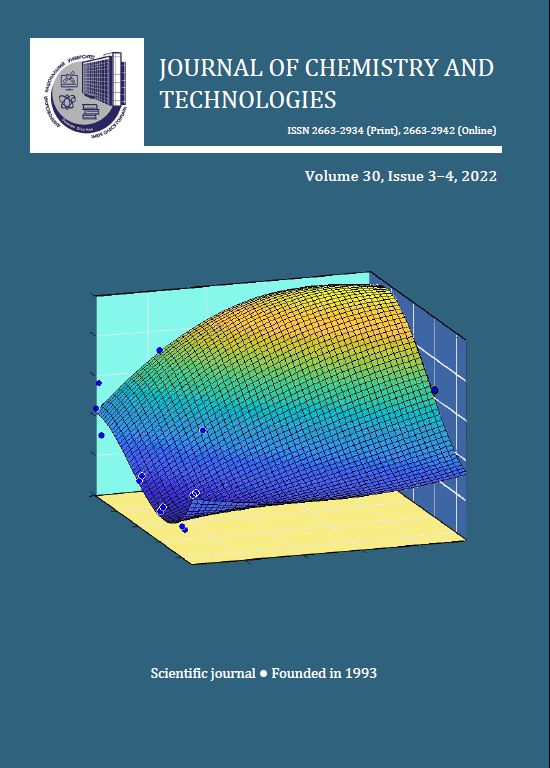MODELING OF THE ADSORPTIVE WATER REMOVAL FROM DICHLOROMETHANE USING THE ASPEN ADSORPTION PROGRAM: ADSORPTION STAGE
DOI:
https://doi.org/10.15421/jchemtech.v30i3.264054Keywords:
solvent technology, process of dehydration, adsorption, dichloromethane, zeolites, breakthrough curves, modeling, Aspen Adsorption, heat exchange, mass transferAbstract
The author proposed a method for calculating an adsorber for removing water from dichloromethane, which involves modeling the process in the Aspen Adsorption program. They used experimental breakthrough curves, conditions of adsorption equilibrium, kinetics, heat transfer, and mass transfer. The developed method makes it possible to determine the breakthrough time and liquid temperature for different values of the adsorber productivity, its dimensions, and the initial water content in dichloromethane. The author found that a “hot spot” appears in the adsorber because of heat release, and the temperature of the liquid in it can differ significantly from the initial one. This factor is essential for choosing the size of the apparatus.
References
Becker, H. (1973). Organicum: Practical Handbook of Organic Chemistry. Oxford, United Kingdom: Pergamon Press. https://doi.org/10.1016/C2013-0-03912-6
Rosenblum, M., Woodward, R. B. (1958). The Structure and Chemistry of Ferrocene. III. Evidence Pertaining to the Ring Rotational Barrier. J. Am. Chem. Soс., 80(20), 5443–5449.
Jović, S., Laxminarayan, Ya., Keurentjes, J., Schouten, J., van der Schaaf, J. (2017). Adsorptive Water Removal from Dichloromethane and Vapor-Phase Regeneration of a Molecular Sieve 3A Packed Bed. Ind. Eng. Chem. Res., 56(17), 5042–5054. https://doi.org/10.1021/acs.iecr.7b00433
Guo, Y., Wang, L. Research Progress on Azeotropic Distilation Technology (2019). Scientific Research Publishing, 9, 333-342. https://doi.org/10.4236/aces.2019.94024
Gerbaud, V., Rodrigyez-Donis, I., Hegely, L., Lang, P., Denes, F. (20190. Review of extractive distillation. Process design, operation, optimization and control. Chemical Engineering Research and Design, 141, 229-271. https://doi.org/10.1016/j.cherd.2018.09.020
Waltermann, T., Skiborowski, M., Efficient optimization-based design of energy-integrated distillation processes. Computers and Chemical Engineering, 129. https://doi.org/10.1016/j.compchemeng.2019.106520
Galiano, F., Casto-Munoz, R., Figoli, A. (2021). Pervaporation, Vapour Permeation and Membrane Distillation: From Membrane Fabrication to Application. Membranes, 11(3), 162. https://doi.org/10.3390/membranes11030162
Hasegawa, Y.; Abe, C.; Ikeda, A. (2021). Pervaporative Dehydration of Organic Solvents Using High-Silica CHA-Type Zeolite Membrane. Membranes, 11, 229–242. https://doi.org/10.3390/membranes11030229
Choi, K. H., Hwang, D. Y., Suh, D. H. Meta-separation: complete separation of organic-water mixtures by structural property of metamaterial // Advanced Materials & Chemical Engineering Building – 2021. – Vol. 311 – P. 222
Choi, H., So Jeong Kim, M. E., Hack Suh, D. (2021). Meta-separation: Improvement of Properties by Molecular Design of Metamaterials for Organophosphorous Flame Retardants. ChemistrySelect, 6, 8011-8015. https://doi.org/10.1002/slct.202101915
Mekala, M., Neerudi, B., Are, P. R., Surakasi, R., Manikandan, G., Kakara, V. R., Abhaykumar, Dhumal, A. A. (2022) Water Removal from an Ethanol-Water Mixture at Azeotropic Condition by Adsorption Technique. Adsorption Science & Technology, Volume 2022, Article ID 8374471, 10 pages/ https://doi.org/10.1155/2022/8374471
Karimi, S., Yaraki, M., Karri, R. (2019). A comprehensive review of the adsorption mechanisms and factors influencing the adsorption process from the perspective of bioethanol dehydration. Renewable and Sustainable Energy Reviews, 107, 535-553. https://doi.org/10.1016/j.rser.2019.03.025Simo, M., Sivashanmugam, S., Brown, C.J., Hlavacek V. (2009). Adsorption/Desorption of Water and Ethanol on 3A Zeolite in Near-Adiabatic Fixed Bed. Ind. Eng. Chem. Res. 2009, 48, 9247–9260. https://pubs.acs.org/doi/10.1021/ie900446v.
van Kampen, J., Boon, J. & van Sint Annaland, M. (2021)/ Steam adsorption on molecular sieve 3A for sorption enhanced reaction processes. Adsorption. 2021, 27, 577–589. https://doi.org/10.1007/s10450-020-00283-8
Andronikashvili, T.G., Kordzakhia, T.N., Eprikashvili, L. G. (2015). Zeolites – The Unique Desiccating Agents of Organic Liquids. https://www.researchgate.net/publication /305999669
Drying by adsorption. www.silica.de
Ruthven, D. M. (1984). Principles of adsorption and adsorption processes. New York, USA: John Wiley & Songs.
Planovsky, A. N., Ramm, V. M., Kagan, S. E. (1962). [Processes and apparatuses of chemical technology]. Moskow, USSR: Goskhimizdat (in Russian).
Pavlov, K. P., Romankov, P. G., Noskov, A. A. (1981) [Examples and tasks for the course of processes and apparatuses of chemical technology]. Leningrad, USSR: Khimiya (in Russian).
Tian, Y., Demirel, S. E., Hasan, M. M. F., Pistikopoulos, E. N. (2018). An Overview of Process Systems Engineering Approaches for Process Intensification: State of the Art. Chem. Engineering and Processing - Process Intensification, 133, 160 – 210. https://doi.org/10.1016/ j.cep.2018.07.014
Towler, G., Sinnot, R. (2012). Chemical engineering design: Principles, Practice and Economics of Plant and Process Design, Elsevier Ltd. https://doi.org/10.1016/C2009-0-61216-2.
Podzharsky, M. A., Nesterov, A. M. (2021). Modeling of the technological process of sulfur dioxide oxidation using the CHEMCAD program. Journal of Chemistry and Technologies, 29(4), 576–585. https://doi.org/10.15421/jchemtech.v29i4.244347
Wood, K. R., Liu, Y. A., Yu, Y. (2018). Design, Simulation, and Optimization of Adsorptive and Chromatographic Separations: A Hands-On Approach, First Edition. Wiley-VCH Verlag GmbH & Co. KGaA.
ES288 Introduction to Aspen Adsorption. AspenTech Customer Education. Training ManualCourse Number ES288.071.07. (2009). Aspen Technology, Inc.
Borosilicate glass
https://en.wikipedia.org/wiki/Borosilicate_glass#:~:text= Borosilicate%20glass%20is%20less%20dense,roughly%20one%20fifth%20of%20water%27s
Downloads
Published
Issue
Section
License
Copyright (c) 2022 Oles Honchar Dnipro National University

This work is licensed under a Creative Commons Attribution 4.0 International License.
- Authors reserve the right of attribution for the submitted manuscript, while transferring to the Journal the right to publish the article under the Creative Commons Attribution License. This license allows free distribution of the published work under the condition of proper attribution of the original authors and the initial publication source (i.e. the Journal)
- Authors have the right to enter into separate agreements for additional non-exclusive distribution of the work in the form it was published in the Journal (such as publishing the article on the institutional website or as a part of a monograph), provided the original publication in this Journal is properly referenced
- The Journal allows and encourages online publication of the manuscripts (such as on personal web pages), even when such a manuscript is still under editorial consideration, since it allows for a productive scientific discussion and better citation dynamics (see The Effect of Open Access).


